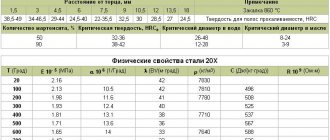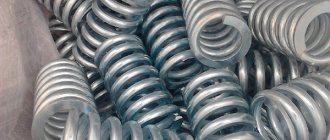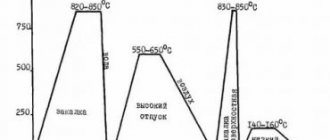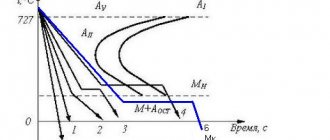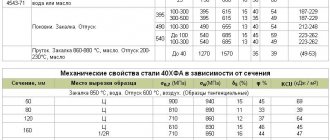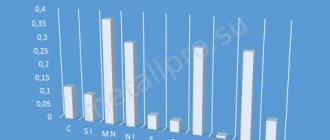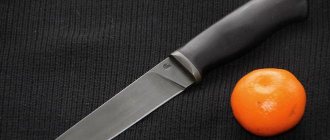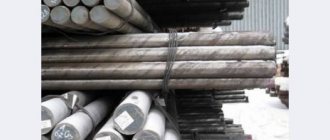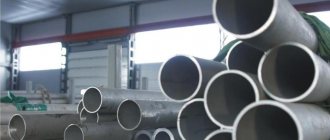Characteristics of steel grade 50
Steel 50 is a structural high-quality carbon steel, difficult to weld, the steel is a limited weldable steel that is prone to cracking when welded by conventional methods. Welding is carried out by RDS and KTS. Heating and subsequent heat treatment are required. For welding St.50, it is recommended to use electrodes UONI13/45, UONI13/55. Good results are obtained by welding with direct current of straight polarity.
Not prone to flake sensitivity, no tendency to temper brittleness. Machinability by cutting in the hot-rolled state at HB 196-202 and σв=650 MPa, K υ solid. spl=1.0 and Kυ b.st=0.7. Forging is carried out at temperatures from 1250 to 800 0C, with air cooling of workpieces with a cross-section of up to 400 mm. Gear wheels, rolling rolls, rods, heavily loaded shafts, axles, tires, lightly loaded springs and leaf springs, plowshares, track link fingers, gearbox clutches, injector housings and other parts that operate on friction are made from steel 50. Steel 50 is used mainly in cast parts and in tool making.
Advantages and disadvantages
The biggest advantage of grade 50 over high-quality stainless steels is its relatively low cost. Therefore, where possible, it replaces them.
Parts made of steel 50 are durable due to their high wear resistance due to friction.
Brand 50 is characterized by the absence of flakes. This is a defect in steels in the form of internal transgranular cracks. Hence the high reliability of structures made of steel 50.
Steel 50 is not subject to temper brittleness. In many steels, after temperature tempering, a decrease in impact toughness is observed. Brand 50 does not have this drawback, so the parts are not afraid of shock loads.
Among the disadvantages of steel 50 are insufficient weldability at normal temperatures, low hardenability, and a tendency to crack when quenched in water.
Supply steel 50
Supplied in the form of long products, including shaped steel according to the regulations of GOST 2590-88 Hot-rolled round steel , GOST 2591-88 Hot-rolled square steel , GOST 8239-89 Hot-rolled steel I-beams , GOST 19771-93 Equal-flange bent steel angles, GOST 19772 -93 Bent steel angles, unequal flanges , GOST 8278-83 Bent steel channels, equal flanges , GOST 8281-80 , unequal , GOST 8283-93 steel trough equal flange profiles , GOST 380-94 Carbon steel of ordinary quality , GOST 85 09-93 Steel corners hot-rolled equal flange , GOST 8510-86 rolled steel angles unequal-flanged , GOST 8240-97 Hot-rolled steel channels , GOST 535-88 Rolled bars and shaped carbon steel of ordinary quality , GOST 2879-88 Rolled hot-rolled hexagonal steel, GOST 19903-2015 Hot rolled sheet products , GOST 19904-90 Cold-rolled sheets , GOST 16523-97 Rolled thin sheets of high-quality and ordinary quality carbon steel for general purpose, GOST 503-81 Cold-rolled low-carbon steel strip, GOST 103-76 Hot-rolled steel strip , GOST 82-70 Hot-rolled steel Wide-band universal, GOST 3282-74 Wire Steel low-carbon general purposes , GOST 17305-71 Carbon structural steel wires, GOST 10705-80 steel power steel pipes , GOST 10706-76 Pipes steel eight-dimensional , GOST 3262-75 Pipes steel water and gap-pipes .
| Metal forming. Forgings | GOST 8479-70; |
| Welding and cutting of metals. Soldering, riveting | GOST 10543-98; |
| Long and shaped rolled products | GOST 5422-73; GOST 2879-2006; GOST 2591-2006; GOST 2590-2006; GOST 9234-74; GOST 1133-71; GOST 11474-76; |
| Sheets and strips | GOST 16523-97; GOST 103-2006; GOST 82-70; GOST 14918-80; GOST 19903-74; |
| Ribbons | GOST 3560-73; |
| Long and shaped rolled products | GOST 14955-77; GOST 8560-78; GOST 8559-75; GOST 7417-75; GOST 1051-73; GOST 10702-78; GOST 1050-88; |
| Sheets and strips | GOST 4405-75; GOST 1577-93; |
| Ribbons | GOST 21996-76; GOST 2284-79; GOST 10234-77; |
| Steel pipes and connecting parts for them | GOST 24950-81; GOST 20295-85; GOST 3262-75; |
| Low carbon steel wire | GOST 792-67; GOST 1526-81; |
| Medium and high carbon steel wire | GOST 26366-84; GOST 17305-91; GOST 9161-85; GOST 7372-79; GOST 9124-85; GOST 3920-70; GOST 9850-72; |
| Metal mesh | GOST 3306-88; |
Main characteristics of steel
Any steel can be characterized by the following indicators:
- Chemical composition.
- Critical points are the main indicator that is taken into account when hardening steel. By conducting scientific experiments, critical points for all metals, including the one under consideration, were identified.
- Mechanical and physical properties. Hardening involves changing the HRC value, which is used to indicate hardness.
It is worth noting that 65G steel, which is used in the production of springs and springs, must have a certain ductility, for which tempering is carried out: annealing means significantly reducing ductility.
Physical properties of steel 50
Features of the hardening carried out
The annealing temperature of steel is 50, that is, the critical points are 725 and 750 degrees Celsius. If the structure is heated to a temperature of 700 degrees Celsius, then allotropic transformations do not begin to occur, which determines the preservation of physical and mechanical properties even after rapid cooling. Hardening must be carried out strictly taking into account critical points.
If the heating temperature is between the two indicated critical points, then ferrite remains in the structure, which is considered a soft component. This moment determines the incomplete increase in hardness, that is, the transformation of the structure has not been completed completely. This method is used to produce metal with an HRC value that is most suitable for die production. In this case, the resulting parts will have good mechanical qualities.
Mechanical properties of steel 50
The optimal temperature in this case is considered to be the range from 800 to 820 degrees Celsius. In this case, the structure becomes fine-grained, which determines the hardness and strength of the material with the best HRC value. Using a high heating temperature before rapid cooling has a detrimental effect on 50 steel, as the grain becomes quite coarse. Large grains determine the deterioration of mechanical properties, for example, increased fragility. Brittle steel cannot withstand variable and impact loads, which leads to part of the part breaking off.
Mechanical properties of rolled steel 50
| GOST | Forging condition | Section, mm | σв(MPa) | δ5 (δ4 ) (%) | ψ % |
| no less | |||||
| 1050-88 | Hot-rolled, forged, calibrated and silver steel of the 2nd category after normalization | 25 | 630 | 14 | 40 |
| Calibrated steel, category 5: | |||||
| after cold hardening | Samples | 660 | 6 | 30 | |
| after annealing or high tempering | Samples | 560 | 12 | 40 | |
| 1577-93 | Annealed or high tempered sheets | 80 | 580 | 17 | — |
| 16523-70 (Transverse samples) | Hot rolled sheet | Up to 2 | 540-720 | -12 | — |
| 2-3,9 | -13 | — | |||
| Cold rolled sheet | Up to 2 | 540-720 | -13 | — | |
| 2-3,9 | -14 | — | |||
Chemical composition and decoding
The composition of high-alloy corrosion-resistant steel 50x14MF is regulated by GOST R50328.1-92:
- carbon (0.48-0.55%) - strengthens steel due to the formation of iron carbides, increasing hardness and endurance;
- chromium (14.0-15.0%) - corrosion inhibitor, provides strengthening during maintenance, improves abrasive wear resistance;
- manganese (within 0.6%) - necessary for deoxidation of steel, purification of the alloy from sulfur and oxygen;
- molybdenum (0.45-0.80%) - the material gains heat resistance and creep resistance as the temperature increases. And also this element provides high hardness of the hardened material, especially since the presence of vanadium (0.10-0.15%) eliminates the formation of temper brittleness, and grain refinement helps improve mechanical characteristics;
- silicon (within 0.6%) provides good strength characteristics (the elasticity and yield strength increases without changing ductility), wear resistance and hardness also improve after maintenance;
- phosphorus and sulfur are within normal limits.
Knife Sarych made of steel 50Х14МФ.
Mechanical properties of steel 50 at elevated temperatures
| Test temperature, °C | σ0.2 (MPa) | σв(MPa) | δ5 (%) | ψ % |
| Sample 10 mm in diameter, 50 mm long, deformed. Deformation speed 5 mm/min. Strain rate 0.002 1/s | ||||
| 700 | 87 | 115 | 39 | 97 |
| 800 | 45 | 81 | 45 | 100 |
| 900 | 16 | 50 | 43 | 100 |
| 1000 | 11 | 36 | 35 | 100 |
| 1100 | 8 | 28 | 41 | 100 |
| 1200 | 8 | 22 | 49 | 100 |
Description and composition
The correct name according to the standard: unalloyed structural special steel 50. In relation to this steel, the definition of “special” appeared recently.
The term, in particular, means strict compliance with the established chemical composition. Not only carbon (0.47–0.55 wt.%) is regulated, but also 7 more elements.
“Unalloyed” does not mean at all that there is nothing else besides carbon and iron.
Manganese may be present in amounts of 0.50–0.80% by weight. The maximum manganese content in unalloyed steels is 1.65% wt.
Other elements in mass percentage:
- Silicon – 0.17-0.37;
- Phosphorus–0.030;
- Sulfur–0.035;
- Chromium–0.25;
- Nickel–0.30;
- Copper–0.30.
Each element plays its role.
Silicon is not an impurity, it is an important component. It acts as a deoxidizing agent and removes harmful ferric oxide, which leads to brittleness. Silicon takes oxygen from oxide and then transfers it to slag in the form of oxide
The presence of manganese eliminates the phenomenon of red brittleness. It improves the surface, promotes malleability and weldability. Like silicon, it participates in deoxidation and also neutralizes the harmful effects of sulfur. Together with silicon it improves hardenability.
Phosphorus and sulfur are harmful impurities. Phosphorus reduces impact strength. Sulfur leads to red brittleness when cracks appear at 800°C. Manganese, reacting with sulfur, forms sulfide with a high melting point and eliminates red brittleness.
Chromium, nickel and copper are not considered harmful impurities in steel 50. They increase resistance to atmospheric corrosion, friction wear resistance, and impact strength.
Mechanical properties of steel 50 at normal temperature
| Type of rental | Size | Eg. | sв | sT | d5 | y | KCU | Heat treatment |
| — | mm | — | MPa | MPa | % | % | kJ/m2 | — |
| Rolled products, GOST 1050-88 | up to 80 | 630 | 375 | 14 | 40 | Normalization | ||
| Cold-worked rolled products, GOST 1050-88 | 660 | 6 | 30 | |||||
| Annealed rolled products, GOST 1050-88 | 560 | 12 | 40 | |||||
| Thick sheet, GOST 1577-93 | 6-60 | 580 | 17 | Annealing |
Cooling methods during hardening
When steel products are rapidly cooled during hardening, there is a risk of large internal stresses occurring, which leads to warping of the material and sometimes cracks. To avoid this, where possible, it is better to cool steel parts in oil. Carbon steel, for which such cooling is not possible, is better cooled in water.
In addition to the cooling environment, the internal stress of steel products is affected by how they are immersed in the cooling environment. Namely:
- It is better to immerse products with a thick and thin part in the quenching liquid with the bulky part first;
- If the product has an elongated shape (drills, taps), it must be immersed strictly vertically, otherwise they may warp.
Sometimes it is not necessary to harden the entire part, but only part of it. Then local hardening is applied. The product is not completely heated, but the entire part is immersed in the quenching liquid.
Mechanical properties of steel 50 depending on tempering temperature
| Temperature, °C | σ0.2 (MPa) | σв(MPa) | δ5 (%) | ψ % | KCU (J/cm2) | HB |
| The diameter of the workpiece is 40 mm. Quenching 840 °C, water. | ||||||
| 400 | 600 | 830 | 14 | 50 | 64 | 240 |
| 500 | 530 | 760 | 15 | 56 | 88 | 215 |
| 600 | 450 | 680 | 17 | 64 | 139 | 190 |
| Workpiece diameter 60 mm. Quenching 840 °C, water. | ||||||
| 400 | 550 | 770 | 14 | 48 | 56 | 217 |
| 500 | 490 | 710 | 15 | 55 | 70 | 200 |
| 600 | 420 | 630 | 19 | 63 | 108 | 180 |
| σ4001/10000 = 100 MPa, σ5001/10000= 50 MPa, σ4001/100000 = 30 MPa, σ5001/100000= 260 MPa | ||||||
Decoding
Steel 50х14мф belongs to the group of high-alloy corrosion-resistant steels. Its properties and chemical composition are regulated by the state standard GOST R50328.1-92. According to it, steel includes the following elements:
- Carbon 0.48-0.55%. As an alloying element, it is the main strengthener of steel. This occurs due to the dissolution of carbon particles in iron and the formation of its carbides. An increase in the percentage of carbon content in steel also leads to an increase in hardness and endurance limit. The negative effect of this alloying is a deterioration in the ductility and weldability of steel.
- Chromium 14.0-15.0%. The main purpose of chromium in steels is to increase the hardening effect from heat treatment, improve anti-corrosion properties and increase resistance to abrasive wear. Among other things, chromium helps maintain mechanical properties at high temperatures. Among the disadvantages of alloying with chromium, it is worth noting the displacement of elements such as sulfur, phosphorus and arsenic by chromium carbides to the metal surface, which leads to increased brittleness. Chromium increases the resistance of steels to the appearance of traces of corrosion, and also generally has a positive effect on the overall mechanical characteristics of steel.
- Manganese no more than 0.6%. The presence of manganese in most steels is simply necessary. This is due, first of all, to the fact that this element is the main deoxidizer for steels. It promotes the removal of oxygen and sulfur, which reduces the level of chemical segregation and has a beneficial effect on mechanical properties. Also, the presence of manganese in the composition has a good effect on the quality of the surface.
- Molybdenum 0.45-0.80%. The introduction of molybdenum into the composition significantly increases the value of heat resistance and creep resistance at high temperatures. Molybdenum also has a positive effect on the hardening effect of steel after heat treatment. In combination with vanadium, this element significantly reduces the likelihood of temper brittleness. - Phosphorus no more than 0.03%. Phosphorus belongs to the group of harmful impurities. Its entry into steel occurs due to imperfections in the technological process of smelting the alloy and insufficient purity of the chemical composition of the charge.
- Phosphorus is a brittle element that tends to settle on the edge of steel crystals, thereby weakening the bond between them. This leads to significant losses in steel strength.
- Sulfur no more than 0.03%. Sulfur, like phosphorus, negatively affects the properties of steel. Its presence in the composition is characterized mainly by the appearance of such an effect as red brittleness, i.e. the tendency of steel to form cracks at elevated temperatures. Sulfur also significantly reduces anti-corrosion properties, endurance limit and wear resistance.
- Silicon no more than 0.6%. The addition of silicon increases strength (elastic limit and yield stress) without reducing ductility. Has a positive effect on wear resistance and the strengthening effect of heat treatment.
- Vanadium 0.10-0.15%. When vanadium is added to the composition, significant grain refinement occurs, which in turn leads to a noticeable improvement in mechanical characteristics. Vanadium also helps remove oxygen and increase the density of steel.
Analogs
The foreign analogue of 50x14MF in terms of both chemical composition and mechanical characteristics is 5Cr14MV steel, regulated by ISO 7151\1-88.
Mechanical properties of steel 50 depending on the section
| Section, mm | σ0.2 (MPa) | σв(MPa) | δ5 (%) | ψ % | KCU (J/cm2) |
| Quenching 850 °C, water. Vacation 580-600 °C, air | |||||
| 50 | 530 | 760 | 15 | 50 | 59 |
| 120 | 470 | 740 | 13 | 40 | 39 |
| 160 | 450 | 740 | 13 | 40 | 39 |
| 200 | 430 | 720 | 13 | 35 | 20 |
| Normalization 830-860 °C, air. Tempering 580-650 °C, air or oven | |||||
| 101-200 | 305 | 610 | 16 | 38 | 34 |
| 201-300 | 305 | 610 | 14 | 33 | 29 |
| 301-500 | 295 | 590 | 12 | 30 | 25 |
| 501-800 | 285 | 570 | 12 | 28 | 20 |
Mechanical characteristics
| Section, mm | holiday t, °C | sТ|s0.2, MPa | σB, MPa | d5, % | d4 | d10 | d10 | y, % | kJ/m2, kJ/m2 | Brinell hardness, MPa |
| Flattened tape of medium strength 0.1-4.0 mm according to GOST 10234-77 in delivery condition (delivery condition is indicated) | ||||||||||
| — | — | — | 780-1270 | — | — | — | — | — | — | — |
| — | — | — | 780-930 | — | — | — | — | — | — | — |
| — | — | — | 930-1080 | — | — | — | — | — | — | — |
| — | — | — | 1080-1230 | — | — | — | — | — | — | — |
| — | — | — | ≤780 | — | — | ≥10 | — | — | — | — |
| — | — | — | ≤570 | — | — | — | — | — | — | — |
| Quenching in water from 840 °C + tempering at 560-580 °C, cooling in air (the place where the sample is cut is indicated) | ||||||||||
| 120 | — | 470 | 760 | — | — | — | — | — | — | — |
| Quenching in water at 840 °C | ||||||||||
| — | 540 | 740 | 880 | 17 | — | — | — | 50 | — | 260 |
| Normalization at 830 °C, air cooling (coarse-grained structure) | ||||||||||
| — | — | 370 | 760 | — | — | — | 10 | 22 | — | — |
| Quenching in water from 840 °C + tempering at 560-580 °C, cooling in air (the place where the sample is cut is indicated) | ||||||||||
| 160 | — | 470 | 760 | — | — | — | — | — | — | — |
| Quenching in water at 840 °C | ||||||||||
| — | 580 | 680 | 810 | 18 | — | — | — | 52 | — | 235 |
| Normalization at 830 °C, air cooling (coarse-grained structure) | ||||||||||
| — | — | 285 | 740 | — | — | — | 20 | 35 | — | — |
| Quenching in water from 840 °C + tempering at 560-580 °C, cooling in air (the place where the sample is cut is indicated) | ||||||||||
| 240 | — | 450 | 760 | — | — | — | — | — | — | — |
| Quenching in water at 840 °C | ||||||||||
| — | 620 | 600 | 750 | 22 | — | — | — | 56 | — | 220 |
| Normalization at 830 °C, air cooling (coarse-grained structure) | ||||||||||
| — | — | 260 | 590 | — | — | — | 20 | 47 | — | — |
| Quenching in water from 840 °C + tempering at 560-580 °C, cooling in air (the place where the sample is cut is indicated) | ||||||||||
| 120 | — | 510 | 800 | — | — | — | — | — | — | — |
| Normalization at 830 °C, air cooling (coarse-grained structure) | ||||||||||
| — | — | 220 | 520 | — | — | — | 37 | 52 | — | — |
| Quenching in water from 840 °C + tempering at 560-580 °C, cooling in air (the place where the sample is cut is indicated) | ||||||||||
| 160 | — | 510 | 800 | — | — | — | — | — | — | — |
| Annealing (fine grain structure) | ||||||||||
| — | — | 570 | 810 | — | — | — | 15 | 40 | — | — |
| Quenching in water from 840 °C + tempering at 560-580 °C, cooling in air (the place where the sample is cut is indicated) | ||||||||||
| 240 | — | 490 | 780 | — | — | — | — | — | — | — |
| Annealing (fine grain structure) | ||||||||||
| — | — | 460 | 780 | — | — | — | 25 | 52 | — | — |
| Cold rolled strip 0.1-4.0 mm according to GOST 2283-79 in delivery condition | ||||||||||
| 0.1-4 | — | — | 740-1180 | — | — | — | — | — | — | — |
| Quenching in water from 840 °C + tempering at 560-580 °C, cooling in air (the place where the sample is cut is indicated) | ||||||||||
| 120 | — | 450 | 740 | 16 | — | — | — | 50 | — | — |
| Annealing (fine grain structure) | ||||||||||
| — | — | 375 | 640 | — | — | — | 25 | 55 | — | — |
| Cold rolled strip 0.1-4.0 mm according to GOST 2283-79 in delivery condition | ||||||||||
| 0.1-1.5 | — | — | ≤640 | — | ≥15 | — | — | — | — | — |
| Quenching in water from 840 °C + tempering at 560-580 °C, cooling in air (the place where the sample is cut is indicated) | ||||||||||
| 160 | — | 430 | 740 | 16 | — | — | — | 45 | — | — |
| Annealing (fine grain structure) | ||||||||||
| — | — | 255 | 450 | — | — | — | 45 | 60 | — | — |
| Cold rolled strip 0.1-4.0 mm according to GOST 2283-79 in delivery condition | ||||||||||
| 1.5-4 | — | — | ≤740 | — | ≥10 | — | — | — | — | — |
| Quenching in water from 840 °C + tempering at 560-580 °C, cooling in air (the place where the sample is cut is indicated) | ||||||||||
| 240 | — | 430 | 740 | 16 | — | — | — | 45 | — | — |
| Cold rolled strip 0.1-4.0 mm according to GOST 2283-79 in delivery condition | ||||||||||
| 0.1-1.5 | — | — | ≤610 | — | ≥15 | — | — | — | — | — |
| Quenching in water from 840 °C + tempering at 560-580 °C, cooling in air (the place where the sample is cut is indicated) | ||||||||||
| 30 | — | 550 | 800 | 18 | — | — | — | 55 | — | — |
| Cold rolled strip 0.1-4.0 mm according to GOST 2283-79 in delivery condition | ||||||||||
| 1.5-4 | — | — | ≤610 | — | ≥13 | — | — | — | — | — |
| Quenching in water from 840 °C + tempering at 560-580 °C, cooling in air (the place where the sample is cut is indicated) | ||||||||||
| 50 | — | 490 | 760 | 18 | — | — | — | 55 | — | — |
| Bar. Quenching in water from 840 °C + Tempering at 560-580 °C, air cooling | ||||||||||
| 25-30 | — | 550 | 800 | 18 | — | — | — | 55 | 780 | — |
| Quenching in water from 840 °C + tempering at 560-580 °C, cooling in air (the place where the sample is cut is indicated) | ||||||||||
| 80 | — | 470 | 740 | 18 | — | — | — | 50 | — | — |
| Bar. Quenching in water from 840 °C + Tempering at 560-580 °C, air cooling | ||||||||||
| 30-50 | — | 490 | 760 | 18 | — | — | — | 55 | 680 | — |
| 50-80 | — | 470 | 740 | 18 | — | — | — | 50 | 590 | — |
| Bar. Quenching in oil from 850 °C + Tempering at 600 °C, air cooling | ||||||||||
| 25 | — | 390 | 650 | 13 | — | — | — | — | — | — |
Steel 08ps structural carbon quality
Physical properties of steel 50
| Temperature | E 10- 5 | a 10 6 | l | r | C | R 10 9 |
| 0C | MPa | 1/Grad | W/(m deg) | kg/m3 | J/(kg deg) | Ohm m |
| 20 | 2.16 | 48 | 7810 | 272 | ||
| 100 | 2.13 | 11.2 | 48 | 487 | ||
| 200 | 2.07 | 12 | 47 | 500 | ||
| 300 | 2 | 12.8 | 44 | 517 | ||
| 400 | 1.8 | 13.4 | 41 | 533 | ||
| 500 | 1.71 | 13.9 | 38 | 559 | ||
| 600 | 1.54 | 14.2 | 35 | 584 | ||
| 700 | 1.36 | 14.5 | 31 | |||
| 800 | 1.23 | 13.4 | 27 |
Hardness of steel grade 50
| Steel hardness 50 hot rolled rod GOST 10702-78 | HB 10 -1 = 217 MPa |
| Steel hardness 50, hot-rolled GOST 1050-88 | HB 10 -1 = 241 MPa |
| Steel hardness 50 rolled calibrated cold-worked GOST 1050-88 | HB 10 -1 = 255 MPa |
| Steel hardness 50 rolled calibrated annealed GOST 1050-88 | HB 10 -1 = 217 MPa |
| Steel hardness 50 rolled hot-rolled annealed GOST 1050-88 | HB 10 -1 = 207 MPa |
Foreign analogues steel 50
| USA | 1049, 1050, 1055, G10490, G10500, G10550 |
| Germany | 1.0535, 1.0540, 1.1206, 1.1213, C50, C50D, C50E, C55, Cf53, Ck50 |
| Japan | S40C, S50C, S53C, S55C |
| France | 2C50, C45E, C50E, C54, XC48H1, XC48H1TS, XC48TS, XC50 |
| England | 060A52, 070M55, 080M50, C50E, C55 |
| European Union | 1.1206, 41Cr4, C50, C50E, C53, C55 |
| Italy | C50, C50E, C50R, C53, C55 |
| Belgium | C53 |
| Spain | C50E |
| China | 50, 55, SM50 |
| Sweden | 1655, 1674 |
| Bulgaria | 50, C50E |
| Hungary | C50E |
| Poland | 55, D50 |
| Romania | OLC50AT, OLC50X |
| Czech | 12051, 12060 |
| Australia | 1050 |
| South Korea | SM50C |
- Structural steel
- Tool steel
Steel analogues 50
If steel 50 is not available, it can be replaced with Russian analogues. These include steels 45, 50G, 50G2, 55. Steels of this class are also widespread abroad.
Here is a short list of them with brands:
- USA–1050;
- Germany, Italy, EU-C50;
- Japan–S50С;
- China, Bulgaria–50;
- France-C50; England, Spain, Hungary – C50E;
- Belgium–C53;
- Poland–55, Romania–LC50AT;
- Sweden–1655.
Conclusion
About 80% of the total volume of steel produced is carbon steel. Among them, brand 50 is far from the last place. Of all the positive qualities described, perhaps the most remarkable is its phenomenal resistance to friction. Thanks to this parameter alone, steel 50 will be used for a very long time.
Rating: 5/5 — 1 votes
